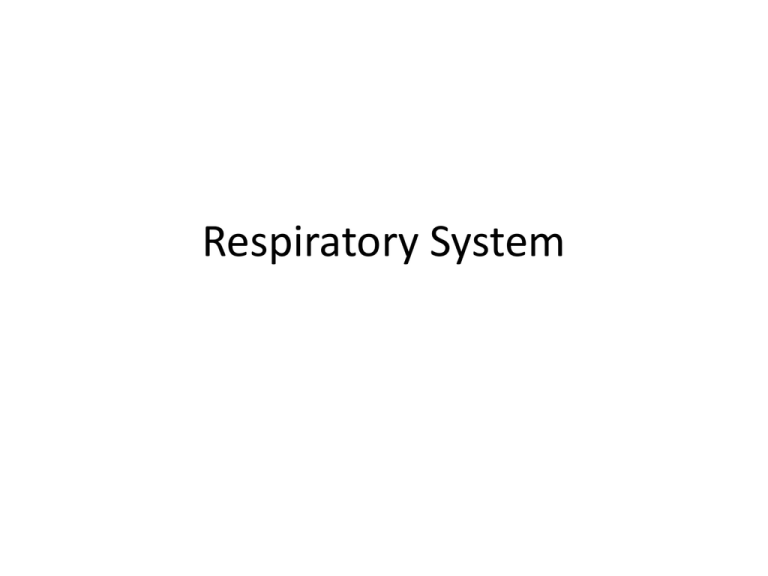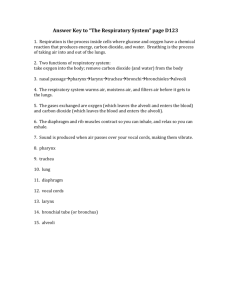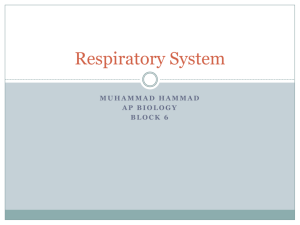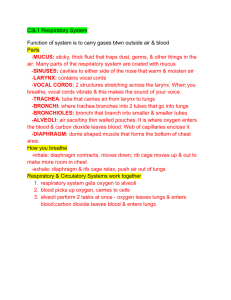Respiratory System
advertisement

Respiratory System Parts of the Respiratory System • The respiratory system has ciliated cells • The lungs are the organ in which this system functions • This system keeps the human body alive and running by oxygenating the blood and removing carbon dioxide • The function is to transport gases to and from the circulatory system Mechanics of Breathing • Breathing is a reaction due to changes of pressure in the thorax. • External respiration in some organisms includes inhaling and exhaling • Humans use the nose, mouth, trachea, lungs, and diaphragm to breathe • The diaphragm is a sheet of muscles that lies across the bottom of the chest cavity and pumps carbon dioxide out of the lungs and pump oxygen in • When the diaphragm contracts it breathes in oxygen and when it relaxes it breathes out the carbon dioxide Alveolus • Alveolus is any of the tiny air cells and lungs where oxygen and carbon dioxide are exchanged • We need this in our body to live or there would be too much carbon dioxide and no oxygen in the lungs • The alveoli have walls that are only one cell thick and are called the respiratory surface • This covers about 70 square meters and is surrounded by the capillaries Alveoli and Capillaries • Alveoli are the tiny air cells of the lungs where carbon and oxygen are exchanged • Capillaries are the arterioles that branch into a network of other tiny vessels • The alveoli are surrounded by the capillaries. The capillaries allow for the exchange of oxygen and other gases. • The imbalance in the exchange of these gases can lead to dangerous respiratory disorders. Ciliated Epithelium • Ciliated Epithelium is a lining on the respiratory passage that defends against infections of the airways. • Smoking breaks down the cilia and slowly wears it away. • Epithelium is a basic type of animal tissue, nervous tissue, and connective tissue • Other functions include absorption, transcellular transport, and detection of sensation Larynx and Pharynx • • • • Larynx is the organ of voice Placed at the upper part of the air passage Forms the lower anterior wall of the pharynx The pharynx acts as a passageways for food on its way to the stomach and air enroot to the lungs. • The larynx joins the trachea and is located directly under the pharynx • Its formed from pieces of cartilage bound together by ligaments • Air is drawn from the pharynx to the larynx Skin’s Role • Skin contains sensory receptors that monitor the external environment and mechanisms that rid the body of wastes • Plants also have respiratory systems but the directionality of gas exchange can be opposite to that in animals • Respiration helps prevent the dehydration Inherited Disorders • Cystic fibrosis is a disease passed down through families that cause thick sticky mucous to build up in the lungs, digestive tract, and other areas of the body • It is one of the most common chronic diseases in children and young adults and it is a life-threatening disorder • Another one is the Cardiac Asthma occurs in left ventricular heart failure and must be distinguished from bronchial asthma Bibliography • • • "Diseases & Disorders of the Respiratory System." IvyRose Holistic : Holistic Health, Alternative Medicine, Human Biology, Anatomy & Physiology and Chemistry Study Pages. Web. 15 Dec. 2011. <http://www.ivyrose.co.uk/HumanBody/Respiratory/Respiratory_Conditions.php>. "Respiratory System Information." University of Pennsylvania Health System | Penn Medicine. Web. 15 Dec. 2011. http://www.pennmedicine.org/health_info/body_guide/reftext/html/resp_sys_fin.html Holt, Rineheart and Winston: Modern Biology







